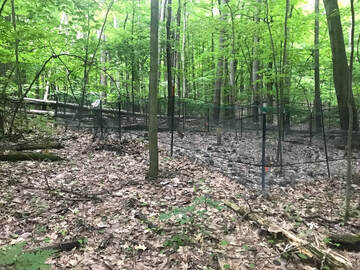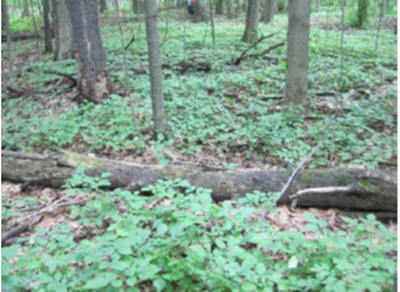research
overview
 Seedling survival
Seedling survival
The goal of my research lab is to elucidate the mechanisms that drive the dynamics of forest communities. We are interested in feedbacks between plants and their soil microbial community and the impact that these feedbacks can have on maintenance of species diversity, migrant colonization potential in response to global climate change and invasion by non-native tree species. We also investigate how abiotic factors (e.g., light and soil resources), tree species functional traits and the interaction between abiotic factors and functional traits can affect the occurrence or strength of these feedbacks. Since forest communities are highly dependent on recruitment dynamics, I have directed my research at the early demographic stages (i.e., seed germination, establishment and survival during the first years). I couple greenhouse studies that allow for rigorous manipulation of growing conditions to ascertain causality with field experiments, which account for the complexity of natural processes.
Examples of some of the broader questions that my lab group addresses include:
Examples of some of the broader questions that my lab group addresses include:
PLANT-SOIL FEEDBACK MAINTAINING TREE SPECIES DIVERSITY
The mechanisms maintaining high species diversity is a central question in community ecology. Two of the most influential mechanisms proposed for tree species coexistence have been negative distance- and density- dependent mortality (NDD), and resource-based niche partitioning. In our lab we investigate whether these two mechanisms are interconnected via PSF.
The mechanisms maintaining high species diversity is a central question in community ecology. Two of the most influential mechanisms proposed for tree species coexistence have been negative distance- and density- dependent mortality (NDD), and resource-based niche partitioning. In our lab we investigate whether these two mechanisms are interconnected via PSF.
- Is the process of plant-soil feedback (PSF) a primary mechanism maintaining tree species diversity?
- Is PSF the causal driver of tree species relative abundance?
- What are the relative effects of soil-borne pathogens vs. mycorrhizae on the PSF that a seedling experiences?
- How does life history traits, such as shade tolerance or mycorrhizal type, influence a species response to PSF?
- How does variation in light and/or soil resources influence PSF?
- What are the important functional traits that reduce seedling susceptibility to PSF?
|
ROLE OF SOIL MICROBES IN TREE SEEDLING SHADE TOLERANCE
Forest community dynamics are driven by species differences in light-dependent survival (shade tolerance). However, shade tolerance is also influenced by interactions with soil-borne microbes and plant functional traits.
Current Collaborators:
Dr. Richard Kobe, Michigan State University Dr. Inés Ibáñez, University of Michigan |
CLIMATE CHANGE
In this research project, we look at the direct effects of current and predicted levels of rainfall and temperature on tree seedling survival, growth and functional traits and indirect climate effects through changes in PSF.
In this research project, we look at the direct effects of current and predicted levels of rainfall and temperature on tree seedling survival, growth and functional traits and indirect climate effects through changes in PSF.
- What is the colonization success of migrant plant species as they may be released from their natural soil pathogens and/or deprived of key symbiotic organisms in their expanded range?
- Is soil pathogen densities associated with conspecific adults greatest in high than in low water availability and temperature?
Regeneration and survival of forested wetlands are affected by environmental variables related to the hydrologic regime. Climate change, specifically alterations to precipitation patterns, may have outsized effects on these forests. In this study, we investigate factors suppressing tree regeneration since the 1970's in a seasonally flooded karst depression.
- Have the number of non-inundated growing days been reduced since the 1970's?
- What is the driving factors behind changes in the hydrology of this wetland?
- Does ponding depth affect the spatial distribution of tree species in this wetland, and how has it changed over time?
Current collaborators:
Dr. Jon Evans, University of the South
Dr. Bill Wolfe, USGS
Dr. Jennifer Cartwright, USGS
Dr. Jon Evans, University of the South
Dr. Bill Wolfe, USGS
Dr. Jennifer Cartwright, USGS
LONG-TERM FOREST COMMUNITY DYNAMICS
In this study, we are examining ~45 years of change in two mature, oak-hickory forested watersheds (i.e., Cross Creek Watershed of Franklin State Forest and Cane Creek Watershed of Fall Creek Falls State Park) on the Cumberland Plateau in southeastern Tennessee.
In this study, we are examining ~45 years of change in two mature, oak-hickory forested watersheds (i.e., Cross Creek Watershed of Franklin State Forest and Cane Creek Watershed of Fall Creek Falls State Park) on the Cumberland Plateau in southeastern Tennessee.
- What is the change in forest composition and biomass accumulation at these sites?
- How have soil resources and microbial community composition changed over the last 45 years?
Current collaborators:
Dr. Jon Evans, University of the South
Dr. Jon Evans, University of the South










